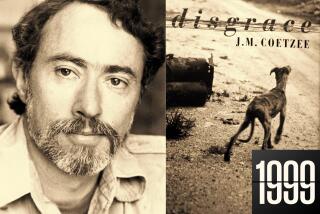Sight Unseen
Gulliverâs travels began with sea voyages that went astray and landed him in places whose blithe oddities were, in fact, dark allegories. The sea was where you traveled back then; Jose Saramago begins his book where we more or less travel today: in an urban traffic jam.
Horns blow furiously as a car fails to move when the light turns green. Inside, the driver screams that he has gone blind. A passerby helps him home--charitably, except that he then steals the car. But the thief goes blind too, and so does the eye doctor whom the first blind man consults. So does everyone in the waiting room, and a woman having sex in a hotel, and the chambermaid, and eventually the entire city.
One could conceive Jonathan Swift adding to Lilliput, Brobdingnag, Laputa and the Houyhnhms another tale: Eyelessia. Saramago calls it âBlindness.â Like Swift he uses airily matter-of-fact detail to frame a bitter parable; unlike Swift he pierces the parable with a dart of steely tenderness. It does not temper the bleakness but opens a hole in it, as Primo Levi wrested radiance from the Holocaust without in the least lightening it.
Saramago, Portugalâs greatest contemporary writer, is the author of such entrancing fictions as âBaltasar and Blimunda,â âThe Stone Raftâ and âThe History of the Siege of Lisbon.â Each, in part, is the world and, in part, a counter-world. Saramago will win the Nobel Prize if his arteries hold out, though the Stockholm people are notably adroit at out-waiting arteries (Borges and Akhmatova, for instance, and just now, grievously, the Polish poet Zbigniew Herbert, who died this summer).
âBlindnessâ is the darkest and most concentrated of Saramagoâs books. With a grim, sometimes monotonously repetitive accumulation of detail, he constructs what in some respects could be a circle of Dantean hell--one of the lower ones, not simply horrific but vile. It resembles âInferno,â in that punishment comes ultimately from within (âWe did not go blind,â one of the character says, âwe are blindâ). It is different because among half a dozen of the afflicted, salvation begins to be constructed, also from within.
The book is in two parts that suggest, respectively, the clenching and unclenching of a fist. When the mysterious blindness spreads through the city--instead of black it turns everything white--the panicked authorities confine the initial wave of the afflicted in an unused psychiatric hospital.
Soldiers guard it and shoot those who try to leave. The steadily growing inmate population is entirely isolated. Food is delivered in canisters dumped at the entrance; there are no attendants, nurses or doctors. The regulations blare twice daily over a loudspeaker: The inmates are to dispose of their garbage, bury their dead and otherwise cope sightlessly for themselves.
Instead of uniting them, blindness isolates the inmates from each other. Darwinian struggles erupt as they grope and dispute their way to the food and the hideously befouled toilets. It is not long before excrement covers the floors and corridors. Blind thugs, armed with staves and a pistol, take over the food supply, extorting valuables at first, and eventually the women. The serial rape, as the victims file in dutifully, ward by ward, is rendered as unimaginable bestiality. Saramago is graphic not so much about physical as moral agony.
Finally a small group, led by the single sighted inmate--she has feigned blindness to stay with her husband, the eye doctor stricken at the beginning--sets the asylum on fire. The inmates rush the gates only to find nobody is guarding them. There are no soldiers, no authorities, no traffic, no services, no commerce. The country has gone blind.
The asylum section of the book is a claustrophobic horror. Saramago has devised an entombment beyond bearing: the triple isolation of blindness, prison and an empty world beyond. Charting this isolation in reiterative detail, âBlindnessâ can be static and wearing. At the same time, though, when the inmates free themselves, the reader shares the explosive sense of release.
It is release into a blasted world. Mobs of the blind roam the streets pillaging the near-empty food stores. Dogs tear at unburied corpses; without running water or electricity the stench of sewage chokes. But Saramago is not after a futuristic nightmare. âBlindnessâ is about the human spirit; its hideousness when it shuts its eyes to others, and redemption when it reaches out to them.
The authorâs horrific vision is a cloud chamber for the spark-trails that flash across it. The inner story of âBlindnessâ--told in the bookâs most splendid passages--is that of half a dozen people who, within the asylum and out of it, struggle to learn their humanity and to exercise it.
Besides the doctor and his wife--strained but heroic under her burden as guide and forager--there are the first blind man and his wife, the woman in the hotel assignation, and an old man with an eye patch. It covers a previously blind eye. He was examining it in the mirror when the white cloud descended on him--one of Saramagoâs many signals that âBlindnessâ is about something other than the eyes.
What this saving remnant possesses, despite the white cloud, is the impulse and gradually the ability to see each other in every way but physically. It is above all the moments of tenderness that distinguish them as they struggle for decency in the asylum and mutual survival afterward.
After the mass rape, the women had returned to the ward carrying the body of a dead victim. They washed the corpse and each other with the bit of water theyâd collected. Tenderness, but as sinewy as the terrible reply the doctorâs wife gives when her husband desolately asks her about the ordeal. The answer is fitting for a holocaust: âThe unnamable exists, that is its name; nothing else.â
Fierceness flashes again when they visit a church where bandages cover the statuesâ eyes, and white daubs streak the eyes of the painted saints. They are blind, the doctorâs wife reflects, âbecause nobody sees them.â Or perhaps it was the priestâs blasphemy âbecause God does not deserve to see.â
Saramagoâs prose is oddly agglutinative, advancing a thought or action and chewing upon it, cudlike. Out of this leisureliness, the ferocity and tenderness shoot suddenly: arrows set alight.
There is, for example, the enchantingly sinuous dialogue of courtship between the old man with the eye patch and the young woman from the hotel. He is unbelieving; she, assured. It is as if they had stepped off the ark when the waters subsided, and she was recalling to him the duty to propagate seeds of insight in an unseeing world. Unseeing, that is, in a profound fashion with which the mysterious white cloud--no doubt it will lift as arbitrarily as it descended--has nothing to do other than as imagery.
More to Read
Sign up for our Book Club newsletter
Get the latest news, events and more from the Los Angeles Times Book Club, and help us get L.A. reading and talking.
You may occasionally receive promotional content from the Los Angeles Times.








